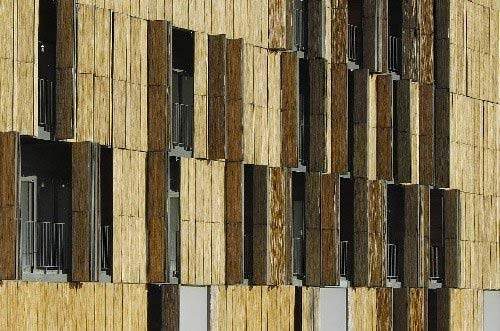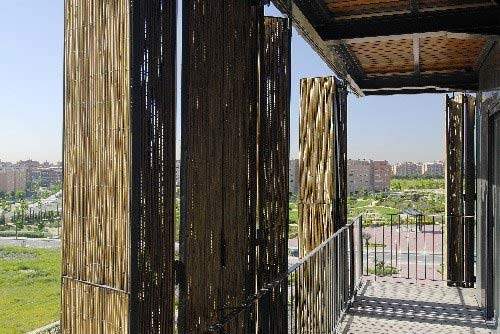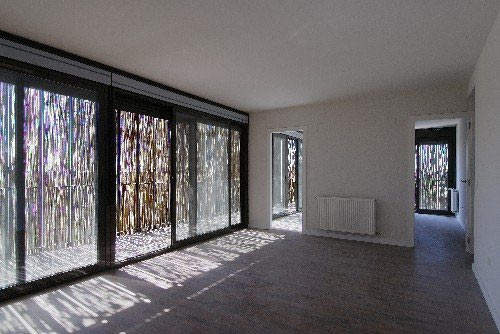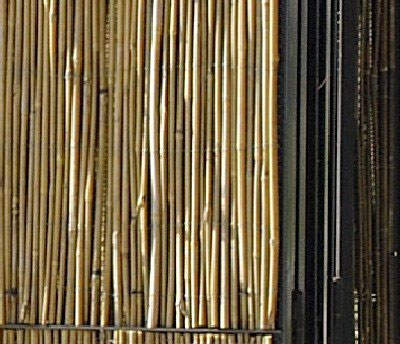In a similar fashion to many European cities Madrid has a housing shortage. Providing new affordable public housing in a sustainable manner is not an easy task.
Foreign Office Architects (FOA) of London are a relatively new firm (established 1995) but have already made a significant impact with international projects such as Yokohama Port Terminal.
FOA have produced a magnificent public housing experiment in a regeneration area in the southern suburbs of Madrid, which is designed to produce an open and sustainable living space for the residents.
The site is a parallelogram oriented north-south and limiting on the west with a new urban park and on the north, east and south with similar housing blocks. The housing block has 88 units of different sizes, with bamboo louvres (shades) as the façade.
The louvres, or shutters on folding frames, provide various functions in that they form an attractive façade, they provide shade to the extensive veranda areas forming part of the living space inside each apartment, they are a sustainable material, they also allow the living space to be opened completely to the outside world to in effect let light, air and the world in when it is a nice day outside.
The housing is the very antithesis of cramped, cheap housing designed with little thought for the eventual occupants. Construction work on the project was finished in March 2007; while there is still some final landscaping to be finished, the first residents moved in at the end of August 2007. The project began in 2003.
CARABANCHEL 16 DESIGN
The basic parallelogram block hosts units of different sizes and shapes, and due to their tube-like interior shape (13.4m tubes connecting the two façades), they all have a double east-west orientation (giving good cross-breeze ventilation), also allowing access to a private garden on the eastern side.
Alejandro Zaera Polo of FOA based his design on a very simple concept, which is low-cost, multi-unit, sustainable and functional, experimenting with the standard ideas on social housing to provide a new open environment. All of the residential apartment units are surrounded with a 1.5m timber floor terrace, which is then enclosed by the bamboo louvres.
The building is organised around the north-south axis, meaning that it faces the harsh east-west sun for most of the day. The louvres' primary function is to shade the interior from the sun and keep the apartments cool.
The project was commissioned by the City of Madrid public works office, the Empresa Municipal de la Vivienda y Suelo (EMVS), who wanted housing at the depressed area of Carabanchel which was more than just accommodation but also made a social statement and provided the residents with a sense of community and a new start.
The building is situated on top of its car park on concrete plinth, which has been disguised and 'landscaped' by cladding it with grass turf. The turf is pinned onto the plinth on top of a special nutrient mat and has automatic sprinklers embedded in it to provide water.
STRUCTURE
Structural columns are incorporated into the walls between the apartments. A further green aspect is the use of solar water-heating panels on the roof, plus wind chimneys to internal bathrooms and kitchens. There is also air conditioning at the developer's insistence.
The rooftop plant is not visible from below, as the bamboo-clad facades are extended upwards on steel frames to conceal it. The bamboo is treated to last, fireproofed, and can easily be cut off the mesh and replaced.
CONTRACTORS
Acciona was the construction contractor for the project. Jesús Hierro of JHS Proyecto de Estructuras y Arquitectura SL was the structural engineer for the project. Alfonso Cuenca Sánchez was the quantity surveyor for the project. Fastaven was the electrical engineer, Asetecnic was the mechanical engineer and Ingeniero Superior de Telecomunicaciones was the telecomunication engineer.
The contract value was €6.06m. Internal areas of the block total 8,183.65m² for apartments, and 3,200.62m² for parking and storage. This makes a total floor space of 11,384.27m².







